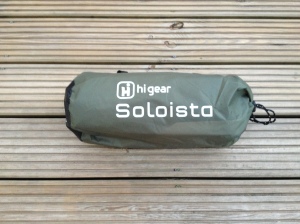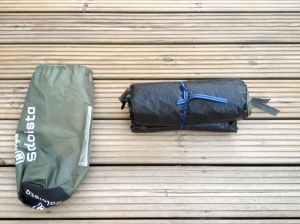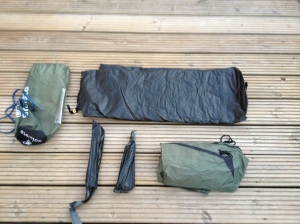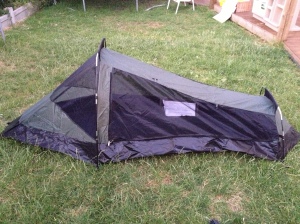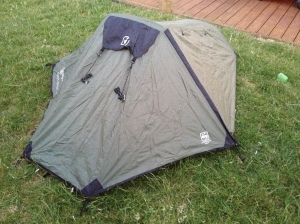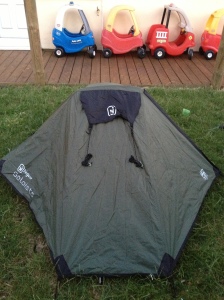The first decision I made about walking the Ridgeway was that I wanted to camp, which of course required a tent. The reason for camping is that it feels a more genuine way to experience the walk, it extends the amount of time spent outdoors, and it feels more in line with the way of the explorer. Camping and backpacking is an exercise in self-sufficiency and looks back to a time where people needed to be able to take their shelter with them as the moved from place to place.
Having made this decision, there were a number of considerations for how to choose my tent for the trip. Chief amongst these was weight, closely followed by cost. Weight is particularly relevant as I am travelling alone, so all of the weight will be carried by me rather than split between two people. Lightweight is clearly the way to go, however it seems that the less your tent weighs the more it costs. Enter stage left the Hi Gear Soloista Backpacking Tent. The ticket price is £50.00 from Go Outdoors with a discount card price of £29.99. However I was lucky enough to buy my tent for £20.00 in a special tent sale by Go Outdoors.
The dimensions of the tent in its bag is 40x15x15 with a weight of 1.63 KG, however when weighed at home it came up slightly heavier at 1.75KG. Not a big difference and from the very unscientific test of holding it in my hand with an outstretched arm this is definitely a light tent. After opening the bag and removing the bundle you can see above that everything packs down into a small roll secured with a plastic fabric tie. These ties are also used on the smaller bags for the poles and pegs (see below). In the dry they are perfectly serviceable and keep things nice and tidy, but I’m a bit wary that they may be difficult to untie in the wet or if tied too tightly. This may be unwarranted and will be tested further during the walk.
The packing system uses the inner as the outer layer of the bundle in which is contained the outer, pegs, and poles. The tent is a tunnel design tent and the structure is formed with two loop poles at either end. I have read one review on the Go Outdoors website that suggests the poles broke on the first time the tent was erected, however I have now put the tent up twice and the poles have shown no signs of cracks or extreme tension. The pegs seem to be fairly standard and maybe a little weak at the top end but this may be down to me being a little heavy-handed when putting them in the ground.
The sunny calm weather that I put the tent up in masks one of the flaws of this tent in that the design means that you have to put the inner up first and then cast over the waterproof outer. Of course this is absolutely fine when you are enjoying the record-breaking sunshine of recent times, but when exposed to the usual, more inclement UK weather this could be a major problem. On the flip side if the tent was used on a trek in sunnier or humid climes then just pitching the inner would make for a more comfortable night.
The outer fits very easily over the top and has two ventilation windows which are kept open through the use of guy lines. Although they are mainly black they do have little white flecks which increase the visibility. Being an ex-military man I very much approve of the Olive Drab Green colour, and although it doesn’t make a damn bit of difference I think that it is quite an aesthetically pleasing tent to look at. The total time for pitching is about 7-10 minutes (this was the second time without taking pictures during the process).
Well that finishes the slightly dry and technical part of the review, let’s get to the important stuff (and I’m not talking about the very impressive line up of Cozy Coupes in the above picture). How is it to actually use? Well in the name of research I spent a night in the tent to concentrate on practicality, comfort, waterproofing, and space. In all honesty this is not a massive tent so I have to confess that I am only 5 ft 4″ with a 30″ waist and probably more flexible than the average bear (I did a lot of gymnastics as a child). I therefore have to be wary of forgetting that I am smaller than most people who might be considering buying this tent.
Practicality
The tent pitches quickly and easily with a minimum of fuss. I used a Mountain Life self inflating sleeping mat and a military issue sleeping bag which fitted easily into the tent and was comfortable and warm. The doorway in the outer can be kept open by using two ties situated inside the flap, as can the inner. The doorway is big enough to get everything inside without any trouble, although this is of course comes with the above caveat concerning my size. The size of the tent when packed is very compact and fits securely onto the bottom straps of my rucksack. One big issue that this tent does have is the lack of storage space under the outer for boots and a rucksack. There does seem to be a reasonable amount of room on the other side from the entrance but this is not very easily accessible. It may be that I will just have to get close and personal with my Bergen during the trip, however that isn’t ideal if it’s soaking wet. I suppose as a 1 person lightweight tent this is to be expected but it is definitely an issue.
Score: 7/10
Comfort and Space
Although the weather during the night was very wet and windy (more on this below), it was still warm and muggy. The ventilation flaps allowed for a comfortable temperature inside the tent, and prevented any serious build up of condensation. There was plenty of room to sleep comfortably without adopting a foetal position, and I was able to move about without touching the inner. In the name of science I did change all of my clothes in the tent and put on my boots. I’m pretty flexible so this wasn’t too much of a problem however I imagine it would be almost impossible if your were bigger and/or less flexible than me.
Score: 7/10
Waterproofing
During the night of the test it absolutely hammered it down. I mean it was almost biblical in the amount that it rained. There was also quite a high wind adding to the force of the rain. Was I wet? Did I get emerge in the morning looking like a drowned rat? Not a bit of it. I was, warm, dry, and so were my boots stored under the outer near the door. There were no leaks through the ventilation flaps, and the ground sheet had prevented any water seeping through. I was very impressed with the tent’s performance in this area and have every confidence that it will stand up to whatever the Ridgeway has to throw at me during the week away.
Score: 10/10
Conclusion
This tent does exactly what is says on the tin. It is extremely cheap, light, and will definitely keep you dry on a wet night. Probably not the best choice for a very tall or large person, but ideal for those who are looking to get into solo backpacking and light weight camping.
Final Score: 8/10

